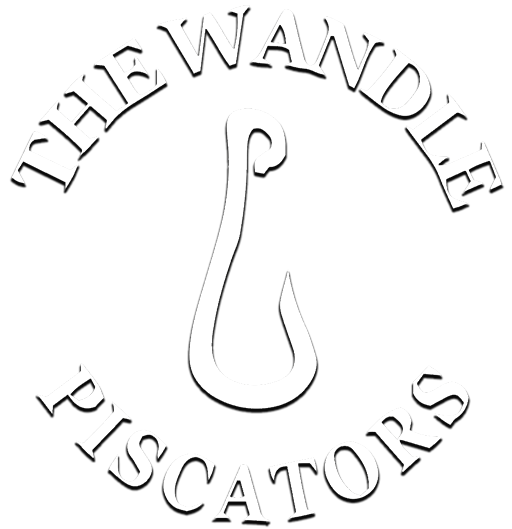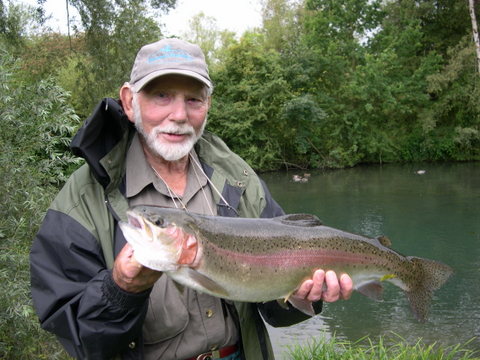(Photo: Neil Patterson)
For the second time this year, the Wandle Piscators have been greatly saddened by the passing of another Patron of the Club: this time the eminent writer, entomologist and angling pioneer John Goddard, who died on Boxing Day at the grand old age of 89.
John was born in Brixton in 1924, and started his angling career on the banks of the Wandle in Hackbridge just 5 years later. According to his close friend and fishing partner Peter Lapsley…
It was on the Wandle, catching sticklebacks and minnows, that he first became engrossed in the secrets of the watery world. He soon acquired his first rod and began laying siege to the roach and dace of London’s rivers. Throughout the whole of the rest of his life, he retained a boyish fascination with fish, fishing and everything that went with them. A life spent mainly in the tackle business provided him with opportunities to fish almost everywhere for almost everything.
After training for service as a paratrooper during the Second World War, John joined his family’s business, F Goddard & Co Ltd – where he soon diversified the product range from garden furniture into fishing tackle under the successful Efgeeco brand.
John became vice-chairman of the Tackle Trades Association, and was appointed as the first chairman of the Angling Foundation in the early 1970s. As a big game angler, he represented England in the EFSA Big Game International Championships, captained the England ‘A’ Team for several years, and helped to pioneer the idea of targeting blue-water species like bonefish, permit, barracuda and sailfish on the fly.
Back in the UK, John was fascinated by entomology, photographing natural flies so that he could tie artificials with complete accuracy, and he soon became a prolific and imaginative fly designer. Over the course of several decades he developed around 30 original patterns including the internationally famous (and famously unsinkable) G&H Sedge, also known as the Goddard Caddis.
He was elected a Fellow of the Royal Entomological Society, and helped to inspire the foundation of the Anglers’ Riverfly Monitoring Initiative by the Natural History Museum and its partners. In 2003, Wandle Piscators Committee Member Adrian Grose-Hodge attended the first southern Riverfly Identification, Survey and Monitoring Workshop, on the Test at Leckford, and recalls how he met John for the first time, and was struck by his encyclopaedic knowledge and modesty:
To brush up a bit before the course I had reviewed a few books and had taken John Goddard’s ‘Waterside Guide’ with me to swot up on, so as to not come across as completely ignorant!
Upon arrival I noticed that most people seemed to know each other, and that there were some well known fisher-folk among us… Before I knew what was happening it was practice time and we were being paired off. An elderly bearded gentleman sidled up to me and asked if I wanted to partner up with him. We spent the morning discussing entomology, or should I say he did and I listened, but one thing that I noticed early on was that everybody else was quite reverent towards him, and that questions which no one else could answer were passed on to him.
It was only when I heard another attendee whisper his name that it all clicked… here I was partnered up with the man whose books I had been looking through! I spent the rest of the day accessing his encyclopaedic knowledge of entomology, collecting samples and catching hatched specimens of upwings with him. Apart from being a gifted teacher and facilitator, he had a lot of patience, which is probably a characteristic that helped him in his studies and writing.
At the end of the day he signed my copy of his book, and I can honestly say that this meeting, had a profound and personal effect in me. I have now been monitoring riverflies on the Wandle for nearly 10 years, and I’m glad to say that my knowledge of aquatic entomology and how to represent different bugs using fur and feather have improved!
John’s skills as a communicator and teacher translated perfectly to television (as below), and his collaboration with co-author Brian Clarke continued right to the end in the form of a joint autobiography which is yet to be published.
He also fished almost every week with Peter Lapsley on the Fulling Mill beat of the upper Itchen: as Peter says, “John’s death will leave a huge hole in all our lives.”
John is survived by his wife Eileen and daughter Susan: we extend our condolences to both.
Update: John’s funeral took place at 1.15pm on Thursday 17 January 2013 at Randalls Park Crematorium in Leatherhead.
Further appreciations of his life have now appeared in the Telegraph, as well as on Gary Borger’s blog and Forelle und Aesche.

